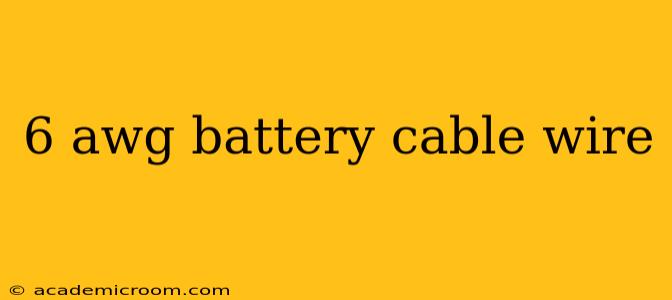6 AWG (American Wire Gauge) battery cable is a popular choice for high-current applications, commonly used in automotive, marine, and other power systems. Understanding its capabilities and limitations is crucial for safe and efficient operation. This guide delves into the specifics of 6 AWG battery cable, answering frequently asked questions and providing valuable insights for anyone working with this type of wiring.
What is 6 AWG Battery Cable Used For?
6 AWG battery cable is designed to handle significant amperage, making it ideal for applications requiring substantial power delivery. Its robust construction ensures reliable performance even under demanding conditions. Common uses include:
- Automotive applications: Connecting batteries to high-draw components like starters, alternators, and powerful audio systems.
- Marine applications: Powering trolling motors, winches, and other high-power equipment on boats.
- RV and camper applications: Supplying power to appliances and systems in recreational vehicles.
- Welding: In certain scenarios, 6 AWG can be used for lower-amperage welding applications, although larger gauges are typically preferred.
- Solar power systems: Connecting solar panels to charge controllers and inverters. (However, larger gauge wire is often preferred for larger solar arrays).
What is the Ampacity of 6 AWG Battery Cable?
The ampacity (current-carrying capacity) of 6 AWG battery cable is not a fixed value. It depends on several factors including:
- Insulation type: Different insulation materials have different temperature ratings, impacting the cable's ampacity.
- Ambient temperature: Higher temperatures reduce the cable's ability to carry current safely.
- Installation method: Proper installation, ensuring adequate ventilation and preventing overheating, significantly affects ampacity.
- Number of conductors in a conduit: Running multiple cables within a conduit reduces the overall ampacity of each cable due to increased heat buildup.
While you'll find various ampacity charts online, it's crucial to consult the manufacturer's specifications for the specific cable you're using to determine its safe operating current under your conditions. Always err on the side of caution and choose a larger gauge if you're unsure.
How Long Can I Run 6 AWG Battery Cable?
The maximum length of 6 AWG cable depends on the voltage drop you can tolerate. Higher currents and longer lengths lead to increased voltage drop, resulting in less power reaching the load. For example, a long run of 6 AWG cable powering a high-amperage device might result in insufficient voltage to operate the device correctly. Voltage drop calculators are readily available online that allow you to input your current, voltage, and cable length to estimate the voltage drop. It's crucial to keep voltage drop below acceptable limits (generally below 3-5%). If a longer run is needed, using a larger gauge wire is the solution.
What Gauge Wire is Equivalent to 6 AWG?
There is no direct "equivalent" gauge to 6 AWG. The American Wire Gauge is a standardized system, and each gauge has specific characteristics. While you can use ampacity charts to find other gauges with similar current-carrying capacity, remember that other factors (like installation and insulation) also impact performance. Choosing a substitute requires careful consideration of the specific application and environmental conditions.
Is 6 AWG Battery Cable Sufficient for My Needs?
This depends entirely on your specific application. To determine if 6 AWG is suitable, you need to know the amperage draw of the device(s) you plan to power. If the amperage exceeds the safe operating capacity of the cable (as specified by the manufacturer, considering all relevant factors mentioned above), you should choose a larger gauge wire. Always prioritize safety. Underestimating the required gauge can lead to overheating, fire hazards, and equipment malfunction.
What Type of Connectors Do I Need for 6 AWG Battery Cable?
6 AWG battery cable requires connectors that are appropriately sized to handle its substantial current-carrying capacity. Using undersized connectors can lead to overheating and potential fire hazards. Look for connectors specifically rated for 6 AWG or larger. Proper crimping techniques are essential to ensure a secure and reliable connection. Improperly crimped connectors can lead to loose connections, resistance, heat generation, and potential failure.
This guide provides a comprehensive overview of 6 AWG battery cable. However, always consult with a qualified electrician or technician if you have any doubts or concerns about your specific application. Safety should always be your top priority when working with electrical systems.
